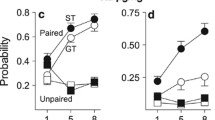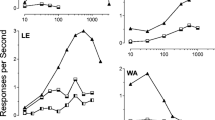Abstract
Environmental stimuli which are repeatedly associated with the nalorphine-induced withdrawal syndrome in morphine-dependent monkeys acquire the ability to produce a variety of conditioned behavioral and physiological responses. Morphine-dependent rhesus monkeys were studied under a fixed-ratio schedule where every tenth lever press produced a food pellet. After several pairings of a stimulus (light or tone) with intravenous injection of a dose of nalorphine which produced an immediate and severe withdrawal syndrome, onset of the stimulus alone produced conditioned suppression of lever pressing, heartrate decrease, vomiting and salivation. Conditioned suppression of responding and conditioned heart-rate changes persisted in post-dependent monkeys for one to four months after termination of chronic morphine treatment. No conditioned electrocardiogram, respiration or temperature changes were ever seen. A second group of morphine-dependent rhesus monkeys was studied under a schedule where every lever press produced an intravenous injection of morphine. After 10 pairings of a light with the intravenous injection of a dose of nalorphine which produced marked withdrawal signs and increased responding for morphine, presentation of the light and injection of sahne produced conditioned increases in responding for morphine. A third group of morphine-dependent rhesus monkeys was studied under a schedule where every nth lever press (n = 1 to 10) terminated a stimulus light associated with periodic injections of nalorphine or naloxone; lever-press responding was engendered and subsequently maintained. Thus, stimuli associated with the nalorphineor naloxone-induced withdrawal syndrome can either suppress, enhance or maintain behavior depending on the schedule conditions.
Similar content being viewed by others
References
Downs, D. A. and Woods, J. H.: Fixed-ratio escape and avoidance-escape from naloxone in morphine-dependent monkeys: Effects of naloxone dose and morphine pretreatment.J. Exp. Anal. Behav. 23:415–427, 1975a.
Downs, D. A. and Woods, J. H.: Naloxone as a negative reinforcer in rhesus monkeys: Effects of dose, schedule, and narcotic regimen.Pharmacol. Rev. 27:397–406, 1975b.
Eddy, N. B., Halbach, H., Isbell, H., and Seevers, M. H.: Drug dependence: Its significance and characteristics.Bull. World Health Organ. 32:721–733, 1965.
Goldberg, S. R.: Relapse to opioid dependence: The role of conditioning.In R. T. Harris, W. M. McIsaac, and C. R. Schuster, Jr. (Eds.): Drug Dependence (Advances in Mental Science, Vol. 2). Austin and London, The University of Texas Press, 1970.
Goldberg, S. R.: Nalorphine: Conditioning of drug effects on operant performance.In T. Thompson and R. Pickens (Eds.): Stimulus Properties of Drugs. New York, Appleton-Century-Crofts, 1971.
Goldberg, S. R.: Behavior maintained by termination or postponement of narcotic antagonist injections in the rhesus monkey.In S. Ehrenpreis and A. Neidle (Eds.): Methods in Narcotics Research. New York, Marcel Dekker, Inc., 1975.
Goldberg, S. R. and Schuster, C. R.: Conditioned suppression by a stimulus associated with nalorphine in morphine-dependent monkeys.J. Exp. Anal. Behav. 10:235–242, 1967.
Goldberg, S. R. and Schuster, C. R.: Conditioned nalorphine-induced abstinence changes: Persistence in post morphine-dependent monkeys.J. Exp. Anal. Behav. 14:33–46, 1970.
Goldberg, S. R., Hoffmeister, F., and Schlichting, U. U.: Morphine antagonists: Modification of behavioral effects by morphine dependence.In J. M. Singh, L. Miller, and H. Lal (Eds.): Drug Addiction: I. Experimental Pharmacology. Mount Kisco (N. Y.), Futura Publishing Co., 1972.
Goldberg, S. R., Hoffmeister, F., Schlichting, U., and Wuttke, W.: Aversive properties of nalorphine and naloxone in morphine-dependent rhesus monkeys.J. Pharmacol. Exp. Ther. 179:268–276, 1971a.
Goldberg, S. R., Woods, J. H., and Schuster, C. R.: Morphine: Conditioned increases in self-administration in rhesus monkeys.Science (Washington)166:1306–1307, 1969.
Goldberg, S. R., Woods, J. H., and Schuster, C. R.: Nalorphine-induced changes in morphine self-administration in rhesus monkeys.J. Pharmacol. Exp. Ther. 176:464–471, 1971b.
Hoffmeister, F. and Goldberg, S. R.: A comparison of chlorpromazine, imipramine, morphine and d-amphetamine self-administration in cocainedependent rhesus monkeys.J. Pharmacol. Exp. Ther. 187:8–14, 1973.
Hoffmeister, F. and Schlichting, U. U.: Reinforcing properties of some opiates and opioids in rhesus monkeys with histories of cocaine and codeine self-administration.Psychopharmacologia 23:55–74, 1972.
Irwin, S. and Seevers, M. H.: Altered response to drug in the post-addictMacaca mulatta.J. Pharmacol. Exp. Ther. 116:31–32, 1956.
Jaffe, J.: Drug addiction and drug abuse.In L. S. Goodman and A. Gilman (Eds.): The Pharmacological Basis of Therapeutics, 5th edition. New York, The Macmillan Co., 1975.
Martin, W. R., Wilder, A., Eades, C. G., and Pescor, F. T.: Tolerance to and physical dependence on morphine in rats.Psychopharmacologia 4: 247–260, 1963.
O’Brien, C.: Experimental analysis of conditioning factors in human narcotic addiction.Pharmacol. Rev. 27:533–543, 1975.
Schuster, C. R.: Variables affecting the self-administration of drugs by rhesus monkeys.In H. Vagtborg (Ed.): Use of Nonhuman Primates in Drug Evaluation. Austin, the University of Texas Press, 1968.
Schuster, C. R.: Psychological approaches to opiate dependence and selfadministration by laboratory animals.Fed. Proc. 29:2–5, 1970.
Smith, W. M., Jr.: Nalorphine as an aversive agent. Proc. 81st Ann. Convention, APA, 1973, pp. 1053–1054.
Tang, A. and Morse, W. H.: Termination of a schedule complex associated with intravenous injections of nalorphine in morphine-dependent rhesus monkeys.Pharmacol. Rev. 27:407–417, 1975.
Teasdale, J.: Conditioned abstinence in narcotic addicts.Int. J. Addict. 8: 273–292, 1973.
Thompson, T. and Schuster, C. R.: Morphine self-administration, food-reinforced and avoidance behaviors in rhesus monkeys.Psychopharmacologia 5:87–94, 1964.
Weeks, J. R. and Collins, R. J.: Factors affecting voluntary morphine intake in self-maintained addicted rats.Psychopharmacologia 6:267–279, 1964.
Wilder, A.: Recent progress in research on the neurophysiologic basis of morphine addiction.Am. J. Psychiat. 105:329–338, 1948.
Wilder, A.: A psychodynamic study of a patient during experimental selfregulated readdiction to morphine.Psychiat. Quart. 26:270–293, 1952.
Wilder, A.: Opiate addiction: Psychological and Neurophysiological Aspects in Relation to Clinical Problems. Springfield, Ill., Charles C Thomas, 1953.
Wilder, A.: Rationale of the diagnosis and treatment of addictions.Conn. Med. J. 19:560–569, 1955.
Wikler, A.: On the nature of addiction and habituation.Br. J. Addict. 57: 73–79, 1961.
Wikler, A.: Conditioning factors in opiate addiction and relapse.In D. M. Wilner and G. G. Kassebaum (Eds.): Narcotics. New York, McGraw- Hill, 1965.
Wikler, A., Fraser, H. F., and Isbell, H.: N-allylnormorphine: Effects of single doses and precipitation of acute “abstinence syndromes” during addiction to morphine, methadone, or heroin in man (post-addicts).J. Pharmacol. Exp. Ther. 109:8–20, 1953.
Wikler, A. Martin, W. R., Pescor, F. T., and Eades, C. G.: Factors regulating oral consumption of an opioid (etonitazene) by morphine-addicted rats.Psychopharmacologia 5:55–76, 1963.
Wikler, A. and Pescor, F. T.: Classical conditioning of a morphine abstinence phenomenon, reinforcement of opioid-drinking behavior and “relapse” in morphine-addicted rats.Psychopharmacologia 10:255–284, 1967.
Woods, J. H. and Schuster, C. R.: Reinforcement properties of morphine, cocaine, and SPA as a function of unit dose.Int. J. Addict. 3:231–237, 1968.
Woods, J. H. and Schuster, C. R.: Opiates as reinforcing stimuli.In T. Thomp-son and R. Pickens (Eds.): Stimulus Properties of Drugs. New York, Appleton-Century-Crofts, 1971.
Woods, L.: The pharmacology of nalorphine (N-allylnormorphine).Pharmacol. Rev. 8:175–198, 1956.
Author information
Authors and Affiliations
Rights and permissions
About this article
Cite this article
Goldberg, S.R. Conditioned behavioral and physiological changes associated with injections of a narcotic antagonist in morphine-dependent monkeys. Pav. J. Biol. Sci. 11, 203–221 (1976). https://doi.org/10.1007/BF03000315
Issue Date:
DOI: https://doi.org/10.1007/BF03000315




